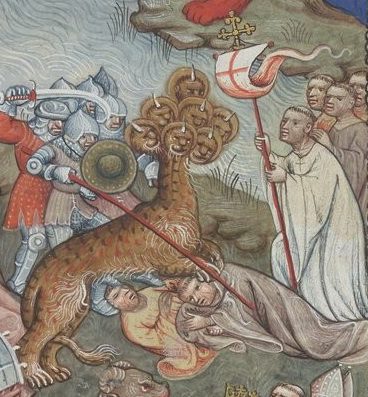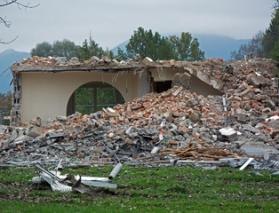Last week’s discussion of Dangerous Times raised the topic of the End Times. That is certainly a fraught issue among Christians, with many ways of getting it wrong (such as predicting the “day and hour” when Jesus says that “no one knows” that, not even Him [Matthew 24:36]).
I told about my student who told me that when he was in grade school, he came home one afternoon to find no one at home, which was unusual at that time of day. He had a panicked feeling that the Rapture had come, taking all the other members of his family but leaving him behind. So he turned on a faucet to see if the water had turned to blood. It hadn’t, so he was comforted.
End Times speculation was very popular when I was growing up. I remember reading about how Henry Kissinger was the Antichrist, and then how it was Mikhail Gorbachev, with the birthmark on his forehead being the mark of the Beast, among many other candidates. More recently some preachers have found Donald Trump in Bible Prophecy, claiming that he is the “last trump” of 1 Corinthians 15:52, which will herald the resurrection of the dead. (Never mind that this works only in English, the original Greek having no connection to the name of our 45th president, and that the shortened form of “trumpet” only appears in the English of the King James translation.)
I stumbled across a discussion of the more classical reading of The Book of Revelation, as opposed to today’s headline-searching, in an article entitled The Apocalypse According to J.R.R. Tolkien by the Romanian scholar and novelist Robert Lazu Kmita. (The Book of Revelation is also known as “The Apocalypse,” which is the Greek word for “revelation.”) An excerpt:
Although difficult to interpret, the allegorical-symbolic language of the Apocalypse is remarkably expressive. Its essence is easy to understand. We are dealing with a cosmic conflict far beyond our powers and comprehension. On one side is the woman—whom Saint Bede the Venerable and many Church Fathers tell us symbolizes the Church—giving birth to all those who convert and receive the sacrament of baptism. On the other side is the red dragon, who seeks to destroy her by causing the loss of those born for the Kingdom of God. The entire 12th chapter of the Apocalypse describes the dragon’s history. This continues in chapter 20, where it concludes after a final attack that, as Saint Bede tells us, will unfold across the face of the whole earth, through an unprecedented spread of heresies and sins that will “besiege” and “persecute” all who strive to remain faithful to the Gospel.
The devil has numerous acolytes. Among these, a prominent place is occupied by the two beasts described in chapters 13 and 19. The first one, coming up from the sea, receives its power from the dragon. Starting a total war with the Christian saints, it will shake even the chosen ones with the violence of the temptations to which it will subject them. Usually, this first beast is identified with theAntichrist uncovered by Saint John in his first epistle. The virtues by which one can confront this beast are two, namely faith and patience (Apoc. 13:10).
The second beast is described in the last part of chapter 13. It rises from the earth and relies on the same power of demonic origin as the first. As a particular accent, it specializes in the performance of false miracles (Apoc. 13:13), deceiving its followers and compelling them to bear the famous “mark of the beast” (Apoc. 13:16-18). Due to its bewitching abilities, the second beast is considered by the vast majority of classical exegetes to be a false prophet.
After a final assault, the ultimate defeat of the three great enemies of God and his saints will come: “And there came down fire from God out of heaven, and devoured them; and the devil, who seduced them, was cast into the pool of fire and brimstone, where both the beast and the false prophet shall be tormented day and night forever and ever,” (Apoc. 20: 9-10).
Kmita then show how those three cosmic figures of evil are reflected in Tolkien’s Silmarillion and Lord of the Rings: Melkor is Satan, Sauron is the Beast, Saruman is the False Prophet.
I found his overview from the church fathers and the early medieval Venerable Bede to be illuminating, especially the distinction between the Antichrist and the False Prophet.
We Lutherans don’t believe in Millennialism, particularly the “postmillenialist” view that Christians will take over the world, set up a utopia, and rule for 1,000 years, after which Jesus will come (Augsburg Confession, Article XVII). But we don’t completely discount Revelation’s application to temporal events, as in the teaching that the pope is the Antichrist (Treatise on the Power and Primacy of the Pope, para. 39).
But, as St. John, the author of Revelation, explains in his epistle, “Children, it is the last hour, and as you have heard that antichrist is coming, so now many antichrists have come. Therefore we know that it is the last hour” (1 John 2:18). The whole era after Christ’s Ascension constitutes the last days, indeed, the last hour. And there are “many antichrists.” John also speaks of the “spirit of antichrist”:
Who is the liar but he who denies that Jesus is the Christ? This is the antichrist, he who denies the Father and the Son. (1 John 2:22)
By this you know the Spirit of God: every spirit that confesses that Jesus Christ has come in the flesh is from God, and every spirit that does not confess Jesus is not from God. This is the spirit of the antichrist, which you heard was coming and now is in the world already. (1 John 4:2-3)
So perhaps we can also speak of the spirit of the False Prophet, who “performs great signs” by which it “deceives those who dwell on earth” so as to make them “worship the beast.” The False Prophet also tells those he deceives “to make an image for the beast,” that is, the first beast, the antichrist, whereupon he is “allowed to give breath to the image of the beast, so that the image of the beast might even speak and might cause those who would not worship the image of the beast to be slain” (Revelation 13;13-15).
Sounds like artificial intelligence to me! Robotics! The Singularity! Could it be that the miracles performed by the False Prophet that lead so many astray are the miracles of technology? I don’t know! Certainly, some people have their heads so turned by modern technology that they deny the Father and the Son and so adopt the spirit of the antichrist.
But the passage is also a warning to charismatics, Pentecostals, Catholics, and other “signs and wonders” Christians: the ability to perform miracles is not necessarily evidence of being in tune with God, but, in these last days, it could mean the opposite.
Have I fallen off the deep end here? If so, pull me back!
Illustration from “Dragon, Beast from the Sea, and the False Prophet,” the Flemish Apocalypse (1450), via Picryl, Public Domain













